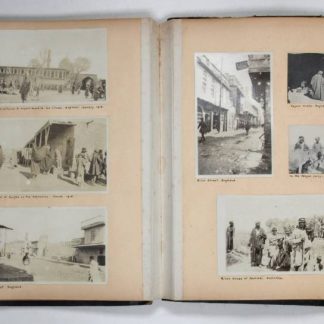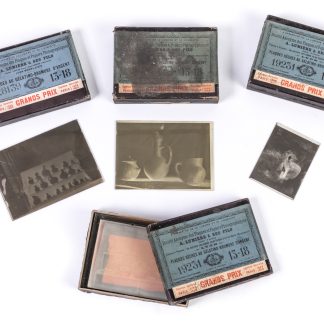The discovery of the necropolis of Yortan
Collection of 42 photographs of archaeological objects and excavation sites in the necropolis of Yortan.
13 x 18 cm and smaller. Glass plate negatives.
€ 15,000.00
Historically important photographical documentation of the first excavations in the bronze-age necropolis of Yortan (3rd millennium AD) led by Paul Gaudin. The prehistoric site is located in western Anatolia, about 100 km east of Pergamon, and is famous for its characteristic ceramics that are defining for the Yortan culture. These ceramics show close similarities to those unearthed by Heinrich Schliemann in prehistoric Troy and in several other sites of the wider region.
Paul Gaudin was leading the construction of a railway line from Soma to Pandera, closely passing by Yortan, when he obtained the license (firman) for excavations in the necropolis through Osman Hamdi Bey, the father of Turkish archaeology. The first excavations were conducted in October of 1898, and a second campaign followed in 1901. The French archaeologist Maxime Collignon wrote a brief excavation report in 1901, and many of the ceramics found are now preserved in the Royal Museums of Art and History, Brussels.
Paul Gaudin was born in Paris, the son of the chemist Marc-Antoine Gaudin (1804-80). His passion for photography was certainly inherited from his pioneering father, who in 1841 introduced the usage of bromine fumes to improve the sensitivity of the plates, allowing for a great reduction of the necessary exposure time, and published the first French journal devoted to photographic research, "La Lumière". In 1880, Paul Gaudin completed his engineering training, obtained a position as deputy stationmaster in Paris, and was subsequently employed as an inspector by the Chemins de fer de l'Ouest. His career took an unexpected turn when he was sent to Turkey in 1892 to direct the Moudania-Brousse railroad line operated by the important Belgian investor and engineer Georges Nagelmackers. As early as 1894, after Nagelmackers had obtained the concession for the Smyrna-Cassaba railway, Gaudin was promoted to director of this important line and led its expansions. Paul Gaudin's lasting contributions to archaeology with his excavations in Yortan and in the Hellenistic and Roman city of Aphrosidias (1904 and 1905), as well as his important collection of antiquities, date to his time in Smyrna (Izmir). His most prestigious and challenging position as a railroad engineer, however, was his charge by Sultan Abdul Hamid II to complete the famous Hejaz railway. Despite financial problems, difficult geographical and climatic conditions, and the often hostile (sometimes even violent) reaction of the local population, Gaudin led the rapid expansion of the line from Ma'an to Medina, where the construction came to a definite halt in 1908. During this project, Gaudin was the first to photographically document the Arabic old town of Al-'Ula in 1907.
Little is known of Paul Gaudin's employment after his contract with the Hejaz railway expired in 1909. He briefly collaborated on the disastrous Ottoman project for the construction of a railway line from Hodeidah to Sana'a in 1911 and seems then to have permanently returned to France, where he died in Versailles in 1921. Today, Paul Gaudin is best remembered as a major patron of the Louvre, to which he donated more than 2,000 artifacts from his collection. The Istanbul Museum, the British Museum, and other institutions also owe him important contributions to their Asia Minor, especially Smyrna, antique collections.
Provenance: 1. Collection of Paul Gaudin, family inheritance. 2. Rouillac auction, 20 June 2022, lot 307.
G. Charloux, Paul Gaudin et les premières campagnes de fouilles à Yortan et à Aphrodisias, in: Orient-Express, no. 1, 2001, pp. 24-26. M. Collignon, Note sur les fouilles de M. Paul Gaudin dans la nécropole de Yortan, en Mysie, in: CRAI, 45/6, pp. 810-817.








